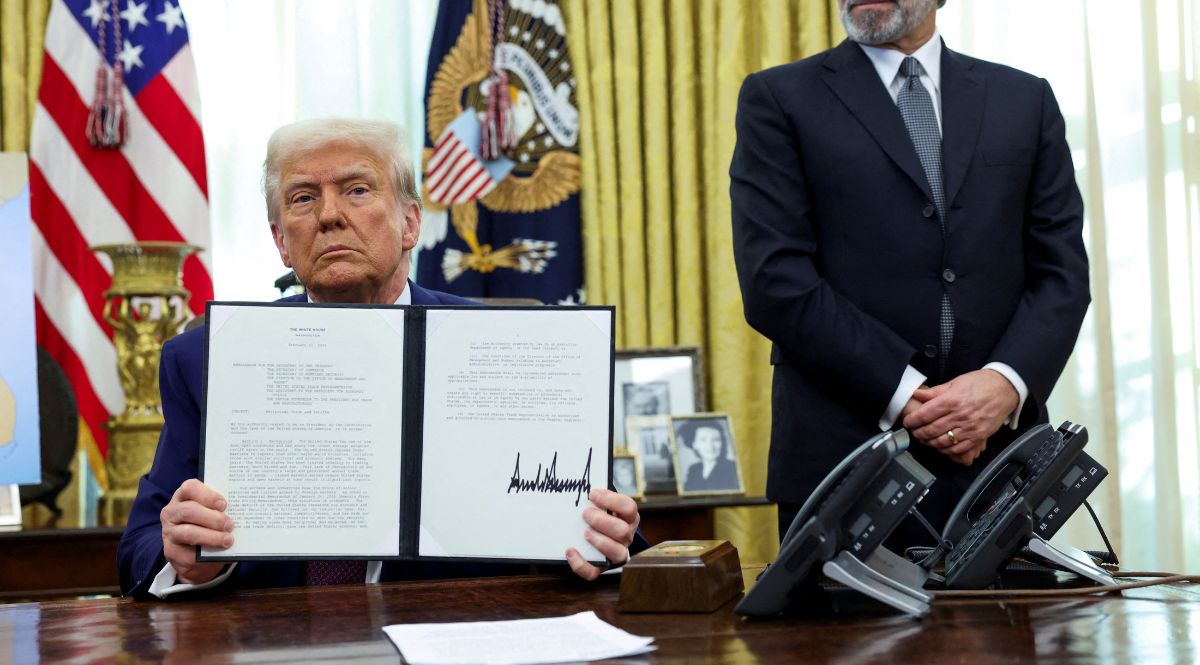U.S. Imposes Tariffs on Steel, Aluminium and Warns of Reciprocal Tariffs
On 10 February, President Donald Trump announced the U.S. will impose a 25% tariff on steel and aluminium imports, followed on 13 February by a threat to impose reciprocal tariffs against countries with higher duties than the U.S. These measures are intended to obtain economic and political concessions, among other things, from partners, but could cause serious disruptions to the global economy and increase the risk of trade wars.
 Kevin Lamarque/Reuters/Forum
Kevin Lamarque/Reuters/Forum
Why is the U.S. imposing the tariffs?
Since the beginning of Trump’s second term on 20 January, trade policy has been one of the main areas of U.S. activity. On 1 February, he announced additional tariffs on goods from Mexico, Canada, and China, citing an insufficient commitment to fight irregular migration to the U.S. and drug trafficking, especially fentanyl. After Trump talked with the leaders of Mexico and Canada, the 25% additional tariffs (10% on Canadian energy) on the two countries were postponed until 4 March in exchange for them stepping up efforts to counter migration and trafficking. The tariffs (10% on all goods) imposed on China, though, came into effect on 4 February. Six days later, China put retaliatory restrictions into effect, including tariffs on LNG from the United States. The U.S. has also threatened to impose tariffs on other partners, especially those with which it has a high trade deficit in goods, including the EU. The Trump administration is also considering imposing tariffs on individual product groups, including cars and computer chips.
What is new?
On 10 February, the U.S. announced 25% tariffs on all steel and aluminium imports, to take effect on 12 March. Trump emphasised that there would be no exceptions for any particular partner, as was the case during his first term. In 2018, the U.S. introduced tariffs on both aluminium (10%) and steel (25%), but after negotiations, Mexico, Canada, Australia and some others were exempted (the EU obtained an exemption from the Biden administration until March this year). The universality of the tariffs is to prevent circumvention of restrictions, including the flow of products from China and Russia to the U.S. through third countries. On 13 February, Trump signed a memorandum on the preparation of a plan to introduce reciprocal tariffs. Their aim is to adjust the level of U.S. tariffs to those imposed by their trading partners. However, it is not known what the tariffs will be for individual countries, as this is to be announced after a screening procedure, which, according to the nominee for commerce secretary, Howard Lutnick, may take until the beginning of April. The administration is to first examine U.S. relationships with countries with which it has both a high trade deficit and faces very high tariffs. Nevertheless, not only tariffs are to be taken into account but also other barriers, such as fees and regulations, that affect U.S. products, including VAT, which may be relevant in the case of the EU.
How are U.S. trading partners responding?
Some countries, including Mexico, the EU, and Canada—the largest supplier of both steel and aluminium to the U.S.—have criticised the tariffs on metals. The European Commission declared that the tariffs are “unlawful” and have “no justification”. It announced it would enact retaliatory measures, possibly the reintroduction of tariffs imposed in 2018 on bourbon and motorcycles from the U.S., among other products. At the same time, Maroš Šefčovič, the EU commissioner for trade, started talks with the U.S. administration on the metal tariffs. Some U.S. trading partners, including Japan and Australia, announced that they will try to obtain exemptions. Trump indicated that Australia might be eligible for one because of the U.S. trade surplus with that country. China criticised the tariffs as violating WTO rules and undermining the global trading system. In reaction to the possibility of U.S. reciprocal tariffs, the European Commission stated that the “EU will react firmly and immediately”. Moreover, Indian Prime Minister Narendra Modi, who was in Washington on the day the memorandum was signed, announced a reduction in tariffs. India has some of the highest tariffs among the main U.S. trade partners, with a weighted average of 12% compared to 2.2% for the U.S.
How could the tariffs affect the global economy?
The tariffs on steel and aluminium by the U.S. and retaliatory tariffs by its partners would strain global economic growth through, for example, higher costs for companies, disruptions in supply chains, and reduced investment due to uncertainty in global trade. The effect would be amplified if the U.S. introduces reciprocal tariffs on a large scale. The magnitude of these effects depends on the duration of the tariffs, adaptation measures taken by companies, and other factors. Supply chains may be altered and exports of steel and aluminium, and potentially other products subject to increased U.S. tariffs, may be redirected to other markets, including the EU, which would increase competitive pressure on them. The continuation of tariffs over a longer period could lead to an increase in U.S. production, including through the attraction of new investments, which is one of the objectives of the Trump administration. However, an increase in U.S. production, including steel and aluminium, would not be immediate nor likely to cover the demand of the U.S. economy. In the short term, increased inflationary pressure can be expected in the U.S. and, if the scope of the tariffs is extended, in other countries as well, depending on the willingness of companies to bear some of the costs.
How will the tariffs affect U.S. relations with other countries?
The Trump administration’s actions, including the postponement of the implementation of various decisions, are intended to strengthen its position in negotiations with partners on concessions to the U.S. in economic matters, but also in other areas, including security. However, they undermine the position of the United States as a predictable trading partner and a reliable ally due to the imposition of tariffs on countries that are, for example, NATO members. Individual partners are likely to attempt to negotiate with the U.S. Their approach will likely depend on their economic potential and relations with the United States. From this perspective, the European Union, the largest trading partner of the United States (in 2024, the bilateral trade in goods amounted to almost $1 trillion), with a large and absorbent market, may have a relatively strong position in the negotiations. However, the U.S. can use the security factor in talks, including the presence of American troops in Europe. Avoiding an escalation of transatlantic trade disputes will be crucial. In the event of a disagreement between individual partners and the U.S., tit-for-tat restrictions are possible, including the introduction of new tariffs as pressure from the U.S. side. The uncertainty introduced by the United States into the global economy will work in favour of its competitors, primarily China, which, in contrast to the Trump administration’s policy, can present itself as a stable and predictable partner.



.jpg)
.png)
.png)